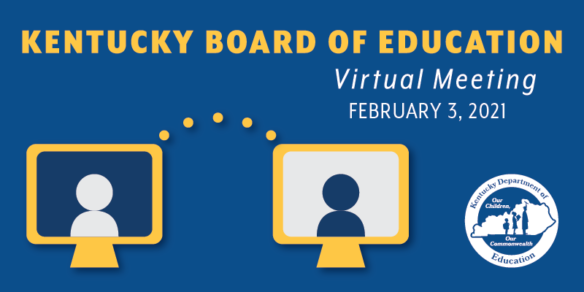
- Since introducing the recommended changes to state’s accountability system, leadership from the department has met with various advisory groups to gather feedback.
- During Education Commissioner Jason E. Glass’ report to the board, he announced an upcoming virtual listening tour that will begin April 6 and continue through May 6.
By Jacob Perkins
Jacob.perkins@education.ky.gov
The Kentucky Board of Education (KBE) voted to approve changes to the state’s accountability system recommended by the Kentucky Department of Education (KDE) during its Feb. 3 regular meeting.
Staff from KDE’s Office of Assessment and Accountability (OAA) proposed changes to the system to align with Senate Bill (SB) 158 (2020), which amends KRS 158.6455 to create an accountability system that includes an annual differentiation of all public schools in the state using multiple measures that describe each district’s overall performance, along with the performances of individual schools and student demographic groups.
SB 158 requires districts to be evaluated on “status” and “change” for state indicators, which include student assessment results, progress toward achieving English proficiency by English learners, quality of school climate and safety, high school graduation rates and postsecondary readiness.
For each indicator, there are five status levels ranging from very high to very low and five change levels, ranging from increased significantly to decreased significantly.
OAA has developed a 5 x 5 color-coded table that combines both status and change. The colors represented on the table are – ranking from low to high – red, orange, yellow, green and blue.
Based on discussions during the KBE’s Nov. 6 special meeting, OAA recommended also using colors to designate an overall performance rating for elementary, middle and high schools. This color system would replace the current star-rating system that was used to communicate school performance.
In the new system, red would represent the lowest rating and blue would represent the highest. Color ratings would have five performance levels including, from highest to lowest, blue, green, yellow, orange and red.
Since introducing all the recommended changes to the board in November, leadership from the department has met with various advisory groups to gather feedback. The majority of the comments received have been on the proposed weights used to combine performances on the multiple indicator measures and the minimum number of students needed for inclusion of school indicators and to form a student demographic group, said Rhonda Sims, associate commissioner in OAA.
While most of the groups agreed with OAA’s recommended weights, members of the School Curriculum, Assessment and Accountability Council (SCAAC) approved a motion to the KBE to consider raising the weight of state assessment results in science, social studies and writing to 30%, while dropping the weight of postsecondary readiness down to 10% at the high school level.
Currently, the recommended high school weights give 45% to state assessment results in reading and mathematics; 20% to state assessment results in science, social studies and writing; 5% to English learner progress; 4% to quality of school climate and safety; 20% to postsecondary readiness; and 6% to graduation rate.
SCAAC members believed by only placing 20% of the weight on state assessment results in science, social studies and writing, these subjects appear devalued, and if more focus was placed on the five core content areas, then students are more likely to be ready for postsecondary education.
Most recently, OAA staff met with the Local Superintendents Advisory Council (LSAC), where council members voiced their approval for the KDE-recommended weights.
LSAC members said if focus is shifted away from postsecondary readiness, schools may see a loss in programs that prepare students for life after graduation and did not want to reduce any opportunities for their students.
As for OAA’s recommendation to set the minimum number of students needed to form a student subgroup for accountability to 30, while still using 10 students per grade for public reporting, LSAC members suggested the department discuss with the U.S. Department of Education (USED) whether schools may use a percentage of their population to calculate their minimum number.
LSAC raised concerns that schools with lower student populations could struggle with a set minimum number of 30, but ultimately voted to approve the recommended changes to the KBE, with the caveat that KDE staff explore flexibilities around the minimum number needed to form a student group with USED.
With the board’s approval, the recommended changes to the state’s accountability system will enter a 60-day public comment period. During this time, members of Kentucky’s education community are encouraged to submit feedback.
Assessments and Racial Equity
OAA staff continued working alongside board members to develop the future of Kentucky’s assessment system and introduced a plan that will involve community input.
When KBE adopted its resolution last July affirming its commitment to racial equity in Kentucky public schools, board members acknowledged that there are areas where progress is needed, specifically in providing equal opportunities for all students and in closing academic achievement gaps, said Jennifer Stafford, director of KDE’s Division of Assessment and Accountability Support.
“There’s a lot of progress to be made in Kentucky,” Stafford said, adding that assessment is one piece of a larger conversation that will lead to the future of education in the Commonwealth and improve equity in Kentucky public schools.
Sims and Stafford presented a three-phase approach that will take the board’s resolution into account, while also gathering feedback from Kentucky’s education community to develop a vision for the future of state assessments.
The approach is designed to engage educators, families and local communities, establish assessment prototypes and then redesign the state assessment system based on those prototypes.
The Center for Innovation in Education, the Center for Assessment, KDE’s Division of Innovation and the Kentucky Innovative Learning Network will be key partners in this work, but Education Commissioner Jason E. Glass said the process will begin with a lot of listening to determine what the public’s aspirations are for the future of education.
“I’m excited about launching into this,” he said. “I don’t know where it’s going to end up yet, but I think it’s going to be a fun journey.”
To gather input on long-term aspirations for the Commonwealth’s education system, Glass will conduct a virtual listening tour beginning April 6.
In addition to the three-phased approach, State Rep. Tina Bojanowski (Louisville) and State Rep. Kim Banta (Ft. Mitchell) have co-sponsored Bill Request (BR) 176, a joint resolution relating to school accountability. BR 176 would require the commissioner of education to convene a strategic Assessment and Accountability Committee to examine opportunities to improve the current approach.
“I feel like all of these things are kind of moving together in support of the bigger question of the future of education,” said Sims.
KDE Equity Initiatives
Thomas Woods-Tucker, KDE’s chief equity officer and deputy commissioner, met with the board to provide updates on the department’s equity initiatives.
KDE currently is speaking to district and school leaders about addressing disproportionality in special education and ensuring access to high-rigor courses like Advanced Placement, International Baccalaureate, Cambridge International and dual credit for all students.
Additionally, the department is engaged in its own continuous improvement through professional learning opportunities with national experts, such as Roger Cleveland, associate professor of educational leadership and policy studies at Eastern Kentucky University.
“We’re going to have to work hard to get people in a comfortable spot of being uncomfortable so that voices are heard and voices are valued,” Woods-Tucker said.
As part of a statewide equity and inclusion scan, Woods-Tucker said districts should examine equitable practices already in place in their schools and ask whether the district itself has an equity and inclusion action plan or includes equity in its strategic plan.
All members of Kentucky’s education community are encouraged to provide feedback on equity and inclusion efforts in their districts.
Woods-Tucker said the department currently is working on creating an equity toolkit that will provide districts and schools with resources which will include equity data assessments, equity scorecards and guidance on how they can facilitate “courageous conversations” about race.
“At the end of the day, this is up to us,” he said. “It’s up to us to feel comfortable enough examining our privilege, but also examining how we have been marginalized and examining our bias. That’s the only way we’re going to chart a path for what the future is going to look like for students.”
Following Woods-Tucker’s presentation, KBE Vice Chair Sharon Porter Robinson told her colleagues on the board that they all will need to stand alongside KDE staff in what will probably become “some really tough debates.”
“The students that we engage now, our learners across the continuum, are the learners that will be responsible for perpetuating a democracy or watching it further deteriorate because we can’t support inclusion of all voices,” she said.
Commissioner’s Report
During Glass’ report to the board, he announced an upcoming virtual listening tour that will begin April 6 and continue through May 6.
Nine sessions will be held across the Commonwealth, one in each cooperative region and one in Louisville, Glass said. These sessions will be in the evening and last approximately 90 minutes.
“I hope to see many stakeholders engaged in these virtual meetings and I look forward to the rich dialogue that will inform our continuous improvement efforts,” said Glass.
Glass also took time during his report to discuss the second round of Elementary and Secondary School Emergency Relief (ESSER) federal funding.
It was announced in early January that Kentucky will receive $928 million in the second round of ESSER. This funding is part of the Consolidated Appropriations Act of 2021, which is the largest and most flexible allocation of discretionary K-12 funding in history.
Staff across the various KDE offices have been working since the announcement to update the agency’s ESSER guidance to reflect these new provisions. The department plans to release this guidance on Feb. 9, Glass said.
Glass’ report concluded with updates on the Kentucky School for the Blind (KSB), the Kentucky School for the Deaf (KSD) and Kentucky’s Area Technology Centers (ATCs).
Both KSB and KSD are continuing to provide virtual instruction to students across the Commonwealth. While both schools have developed reopening plans, due to the increasing COVID-19 cases across the state, KSB and KSD remain closed, with only essential personnel on campus through the end of February.
Based on the recommendation from the Kentucky Department for Public Health, the state schools are providing small group instruction to students within the students’ counties of residence. For students living in Jefferson (KSB) and Boyle (KSD) counties, small group services may occur at the school, Glass said.
For students living in other counties, school staff are collaborating with local school districts to provide a location for small group instruction.
“We know that this is an incredibly vulnerable group of students and it’s really urgent that we restore some of the services that they have missed out on this past year,” said Glass.
On Jan. 11, Kentucky’s 51 ATCs implemented hybrid schedules in order to serve students face-to-face. The hybrid schedule enables the ATCs to provide and maximize in-person instruction while adhering to the Healthy at School guidance, Glass said.
Virtual instruction is concurrently offered to students who have elected a virtual option and to students in feeder districts who have not yet returned to face-to-face instruction.
In other business, the board:
- Approved of the KBE Robinson Award for Diversity and Equity in Public Education Award recipients;
- Approved KBE member participation in the 2021 National Association of State Boards of Education virtual legislative conference;
- Received an overview of the annual Kentucky KIDS COUNT report from Terry Brooks, executive director of the Kentucky Youth Advocates organization;
- Heard reports from Amanda Ellis, associate vice president of the Kentucky Council on Postsecondary Education, and Lt. Gov. and Education and Workforce Development Cabinet Secretary Jacqueline Coleman, who serves as an ex officio KBE member;
- Approved consent agenda items:
-
- New district facility plans for Leslie County, Martin County, Owen County and Russellville Independent;
- District facility plan amendments for Madison County;
- 2020-2021 local district tax rates levied;
- Waiver requests from the Knox County School District related to the Kentucky School Facilities Planning Manual incorporated by reference in 702 KAR 4:180;
- Kentucky School for the Blind Advisory Board appointment;
- Presented the Special Education Teacher of the Year award to Savannah Boone, an exceptional child instructor at LaRue County High School;
- Presented the Mary May Wyman Outstanding Member of the Year Award to KDE Associate Commissioner Gretta Hylton;
- Presented the 2020 Kevin C. Brown Strategic Priority Award to Soup for the Soul, a nonprofit group feeding families in Murray;
- Approved the local district working budget for Ashland Independent;
- Reviewed KDE’s strategic planning dashboard and results from the department’s Keep, Stop, Start survey;
- Heard an overview of the process for developing KDE’s 6-year capital improvement plan;
- Heard updates on the progress pertaining to the Fiscal Year 2022 state budget and legislation currently being considered by the Kentucky General Assembly; and
- Discussed Kentucky’s second allocation of federal CARES Act funding.




Leave A Comment